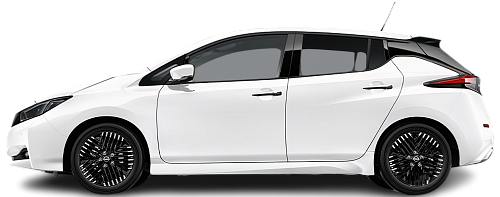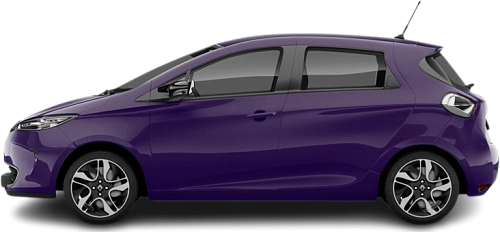Nissan Leaf 40 kWh vs Renault Zoe Z.E. Q210
Struggling to Decide? Let AI Help!
Your AI Summary Is Ready!
General Info
The Nissan Leaf 40 kWh (2022-…) is currently produced, it has a starting price of $29280. The Renault Zoe Z.E. Q210 (2012-2016) has been discontinued, it was never offered for sale in the United States.
The two vehicles share the same body style: Hatchback.
| Property | Nissan Leaf 40 kWh | Renault Zoe Z.E. Q210 |
|---|---|---|
| Years of Production | 2022-… | 2012-2016 |
| Current Status | Produced | Discontinued |
| Country of Manufacture | Japan, UK, USA | France |
| Body Style | Hatchback | Hatchback |
| Market Availability | EU, USA | EU |
| Price USA (New) | $29280 | - Price USA (New) |
| Price USA (Used) | $9999 | - Price USA (Used) |
| GCC Score | 4.8 | 5 |
Range and Efficiency
While the Nissan Leaf 40 kWh (2022-…) offers a longer real-world range and a bigger battery, it is less energy-efficient than the Renault Zoe Z.E. Q210 (2012-2016).
| Property | Nissan Leaf 40 kWh | Renault Zoe Z.E. Q210 |
|---|---|---|
| Range (EPA) | 149 mi | - Range (EPA) |
| Range (WLTP) | 177 mi | - Range (WLTP) |
| Range (GCC) | 148 mi | 98 mi |
| Battery Capacity (Nominal) | 40 kWh | 25.9 kWh |
| Battery Capacity (Usable) | 39 kWh | 23.3 kWh |
| Efficiency per 100 mi | 26.4 kWh/100 mi | 23.8 kWh/100 mi |
| Efficiency per kWh | 3.79 mi/kWh | 4.21 mi/kWh |
| Range and Efficiency Score | 5.6 | 5.7 |
Charging
Both vehicles utilize a standard 400-volt architecture.
The Renault Zoe Z.E. Q210 (2012-2016) has no DC fast charging capability, whereas the Nissan Leaf 40 kWh (2022-…) can charge at up to 50 kW.
The Renault Zoe Z.E. Q210 (2012-2016) features a more powerful on-board charger, supporting a maximum AC charging power of 43 kW, whereas the Nissan Leaf 40 kWh (2022-…) is limited to 6.6 kW.
| Property | Nissan Leaf 40 kWh | Renault Zoe Z.E. Q210 |
|---|---|---|
| Max Charging Power (AC) | 6.6 kW | 43 kW |
| Max Charging Power (DC) | 50 kW | - Max Charging Power (DC) |
| Architecture | 400 V | 400 V |
| Charge Port | CHAdeMO | Type 2 (Mennekes) |
| Charging Score | 3.3 | 5.9 |
Performance
Both vehicles are front-wheel drive.
The Nissan Leaf 40 kWh (2022-…) boasts greater motor power and accelerates faster from 0 to 60 mph.
| Property | Nissan Leaf 40 kWh | Renault Zoe Z.E. Q210 |
|---|---|---|
| Drive Type | FWD | FWD |
| Motor Type | 1 motor: PMSM | 1 motor: PMSM |
| Motor Power (kW) | 110 kW | 65 kW |
| Motor Power (hp) | 148 hp | 87 hp |
| Motor Torque | 236 lb-ft | 162 lb-ft |
| 0-60 mph | 7.7 s | 13 s |
| Top Speed | 90 mph | 84 mph |
| Performance Score | 3.1 | 1.7 |
Dimensions
The Nissan Leaf 40 kWh (2022-…) is longer and wider, but the Renault Zoe Z.E. Q210 (2012-2016) is taller.
The Nissan Leaf 40 kWh (2022-…) boasts a more extended wheelbase.
| Property | Nissan Leaf 40 kWh | Renault Zoe Z.E. Q210 |
|---|---|---|
| Length | 176.4 in | 160.8 in |
| Width (with Mirrors) | 79.9 in | 76.6 in |
| Width (w/o Mirrors) | 70.5 in | 68.1 in |
| Height | 61.5 in | 61.5 in |
| Wheelbase | 106.3 in | 101.9 in |
Cargo and Towing
The Nissan Leaf 40 kWh (2022-…) features a larger trunk, but the Renault Zoe Z.E. Q210 (2012-2016) offers greater maximum cargo capacity when the rear seats are folded.
Neither car is equipped with a frunk (front trunk).
Neither vehicle is officially rated for towing in the US.
| Property | Nissan Leaf 40 kWh | Renault Zoe Z.E. Q210 |
|---|---|---|
| Number of Seats | 5 | 5 |
| Curb Weight | 3509 lb | 3236 lb |
| Cargo Volume (Trunk) | 23.6 ft3 | 11.9 ft3 |
| Cargo Volume (Max) | 30 ft3 | 43.3 ft3 |
| Cargo Volume (Frunk) | - Cargo Volume (Frunk) | - Cargo Volume (Frunk) |
| Towing Capacity | - Towing Capacity | - Towing Capacity |
| Cargo and Towing Score | 4.5 | 4.2 |




